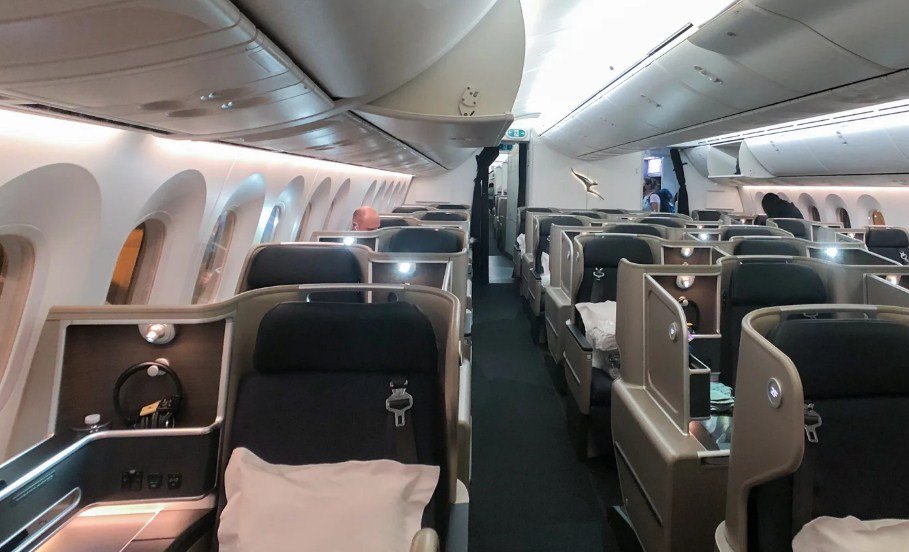In 2005, a new airline emerged in the Australian market, promising to offer a premium service for business travellers at an affordable price. OzJet, founded by millionaire Paul Stoddart, aimed to challenge Qantas on the lucrative Sydney-Melbourne route, using a fleet of three Boeing 737s fitted with only 60 business class seats each. However, the venture lasted for only 14 weeks, before it was forced to suspend operations due to low demand and high costs. Here is the story of OzJet, Australia’s short-lived ‘all business class’ airline.
A unique approach for high flyers
Stoddart, who was then the owner of Italy’s Minardi Formula One team and founder of charter airline European Aviation, saw an opportunity to tap into the business travel market in Australia after the collapse of Ansett in 2001. With Virgin Blue and Jetstar being all-economy budget carriers, Qantas remained the only domestic airline with business class. Stoddart felt that he could offer a better alternative for time-pressed and comfort-seeking travellers, using a unique approach tailor-made for high flyers.
Central to this was OzJet’s fleet of three Boeing 737-200s, each fitted with just 60 business class seats from tip to tail. With only 15 rows of seating arranged in a 2-2 configuration, 47cm between the armrests and ample legroom for stretching out, “it’s about the closest (people) will come to a corporate jet,” OzJet General Manager Hans van Pelt said at the time. Those passengers would pay no more than a flexible economy booking on Qantas: which, at the time, meant OzJet pricing was $325 one way or $650 return.
Once on board, complimentary hot meals were served on bone china, with a free pour of alcoholic and non-alcoholic beverages. Stoddart eschewed airport lounges as costly, capital-intensive frills: OzJet operated on a ‘turn up and go’ model to suit time-pressed business travellers. Combined with online check-in and printing your own boarding pass at home or the office, passengers could arrive at the airport as little as 15 minutes before departure and zip straight through to the boarding gate. There’d be little time lost on arrival, either: a generous cabin baggage allowance of up 20kg, over as many as three pieces of luggage, avoided a pit stop at the baggage carousel.
A rocky start and a rapid end
Ahead of OzJet’s inaugural Melbourne-Sydney flight on November 29 2005, Stoddart was already eyeing an expansion to Brisbane – that other corner of the east coast’s ‘golden triangle’ – followed by Canberra and Adelaide, while transcontinental flights to Perth would tap into the lucrative resources boom. He also planned to add more Boeing 737s to his fleet, as well as larger Boeing 757s for international routes.
However, things did not go as smoothly as he hoped. OzJet faced several regulatory hurdles and delays before it could launch its first flight. It also faced fierce competition from Qantas and Virgin Blue, who slashed their fares and increased their frequencies on the Sydney-Melbourne route. Moreover, OzJet struggled to attract enough customers to fill its planes, despite offering discounts and promotions. Many travellers were reluctant to switch from their preferred airlines or loyalty programs, or were put off by OzJet’s older planes and lack of lounges.
By February 2006, OzJet had suspended its flights between Sydney and Melbourne due to low demand and high costs. It tried to reposition itself as a charter airline, offering flights to destinations such as Norfolk Island and Bali. It also attempted to revive its scheduled services by launching flights between Perth and Derby in Western Australia in April 2006. However, these efforts proved futile, as OzJet continued to lose money and market share. In May 2006, Stoddart sold his stake in OzJet to HeavyLift Cargo Airlines, a British-based freight company. OzJet ceased operations in June 2007.
A lesson learned from OzJet’s failure
OzJet’s failure was not surprising, given the challenges it faced in the Australian market. It was not the first nor the last airline to try to offer an all-business-class service on domestic or international routes. Several other airlines have attempted this model over the years, such as Eos Airlines, MAXjet Airways and Silverjet in the UK-US market; L’Avion and OpenSkies in the France-US market; Paramount Airways in India; and La Compagnie in the France-New York market. Most of them have either gone bankrupt or been acquired by larger airlines.
The lesson learned from these examples is that offering an all-business-class service is not enough to succeed in the competitive aviation industry. It requires a clear value proposition, a loyal customer base, a strong brand identity, a sustainable cost structure, and a flexible strategy to adapt to changing market conditions. OzJet lacked most of these elements, and thus failed to take off.

